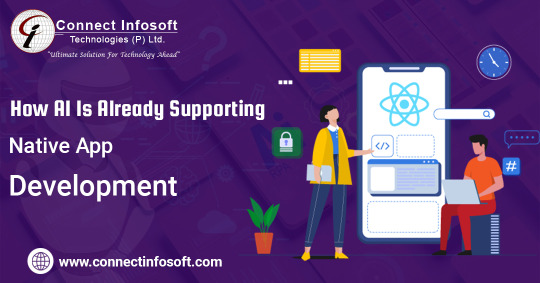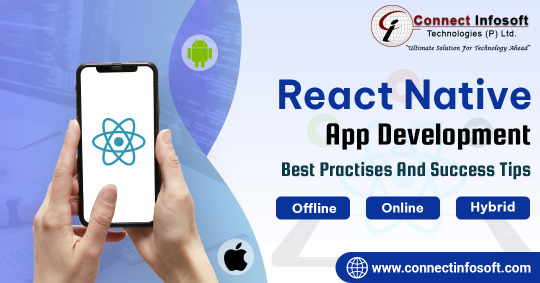#reactnativeapplicationdeveloper
Explore tagged Tumblr posts
Text

Our skilled developers leverage React Native's efficiency to create fast, responsive, and visually stunning mobile apps for your business.
Let's build innovative mobile applications that engage users and drive results.
#connectinfosoft#reactnative#applicationdevelopment#reactnativeapplicationdevelopmentservice#reactnativeapplicationdevelopment#reactnativeapplicationdevelopmentcompany#reactnativeapplicationdevelopmentteam#reactnativeapplicationdeveloper#reactnativeapplicationdevelopmentexpert#appdevelopment#softwaredevelopment#webdevelopmentcompany#webdesigningcompany#usa#india#canada#unitedstates#bulgaria#sofiacity#california#newyork#florida#europe#middleeast#uk#trending#trendingshorts#mobileapps#reactnativedev#techsolutions
1 note
·
View note
Text

#connectinfosofttechnologies#connectinfosoft#reactnative#reactnativedevteam#reactnativedevelopment#reactnativeappdevelopment#reactnativedeveloper#reactnativeapps#reactnativeapplicationdevelopment#reactnativedevelopers#mobileappdevelopment#reactnativemobileappcompany#hirereactnativedevelopers#websitedesignanddevelopment#artificialintelligence#ai#naturallanguageprocessing#machinelearning#ecommerceapplicationdevelopment#softwaredevelopment#webdevelopment#india#usa#trending#trendingshorts#techtrend#reels#itcompany#techblog
2 notes
·
View notes
Link
#reactnativeappdevelopment#reactnativeappdevelopmentcompany#reactnativeappdevelopmentservices#reactnativemobileappdevelopment#reactnativeapplicationdevelopment
1 note
·
View note
Photo

Hire dedicated React native developers for custom React native app development on hourly/full time basis. Direct Communication with Team. Hire React Native Developers that undergoes constant research and development to execute with best possible application solution.
0 notes
Text
React Native Application Development Services
Our React Native Application development services offer in-depth expertise in developing flawless hybrid mobile applications. We deliver quality-at-speed cost-efficiently. Learn more: https://qainfotech.com/mobile-app-development.html #ReactNative #MobilitySolution #AppDevelopmentServices #ReactNativeApplicationDevelopment

0 notes
Photo

https://tinyurl.com/y7f74g3n React Native is a cross-platform framework that helps to build high-quality #apps. Hire a #ReactNativeapplicationdevelopment team for your next smart application. #reactnative #mobileapplication #androidapplication #iosmobileapplication #nativeapplication
0 notes
Text

React Native app development offers several benefits for developers and businesses.
#ConnectInfosoftTechnologies#ConnectInfosoft#ReactNative#AppDevelopment#BestPractices#SuccessTips#ReactNativeDevTeam#ReactNativeDevelopment#ReactNativeAppDevelopment#LookingforReactNativeDeveloper#ReactNativeApps#ReactNativeApplicationDevelopment#ReactNativeDevelopers#LookingReactNativeDevelopers#LookingReactNativeMobileAppCompany#HireReactNativeDevelopers#WebDevelopersinIndia#WebDesignersinIndia#WebDesigningCompany#softwaredevelopment#webdevelopment#india#usa#Trending#Trendingshorts#techtrend#reels#ITConsultant#ITCompany#ITIndustry
1 note
·
View note
Link

#reactnativeappdevelopmentuae#reactnativeappdevelopmentcompany#reactnativeappdevelopmentservicesuae#reactnativemobileappdevelopment#reactnativeapplicationdevelopment
0 notes
Text
React Native Application Development Services
With QA InfoTech's customized solutions within React Native application development services, deliver a seamless application to users by building the perfect UI.
Reach out to our experts to understand more about the service- https://qainfotech.com/mobile-app-development.html #ReactNativeApplicationDevelopmentServices #MobileAppDevelopment #ReactNative #ReactNativeAppDevelopment #ReactNativeApplicationDevelopment

0 notes
Text
React Native Application Development Services
More and more businesses are moving towards react native application development services for its many advantages. It offers cross-platform compatibility, adaptiveness to different screen sizes and high speed for your apps. To know more, visit: https://qainfotech.com/mobile-app-development.html #MobileApplicationDevelopmentServices #ReactNative #MobileAppDevelopmentServices #ReactNativeApplicationDevelopment #ReactNativeApplicationDevelopmentServices

0 notes
Text
How React Native 0.61 Fast Refresh is Enabling Efficiencies for Developers?
The new Fast Refresh feature in the React Native 0.61 update is the combination of existing “live reloading” and “hot reloading”. It now supports the latest React along with Hooks and function components. Read more at- https://qainfotech.com/how-react-native-0-61-fast-refresh-is-enabling-efficiencies-for-developers/ #ReactNativeApplicationDevelopment #TechnologyBlog #BlogPost

0 notes
Text
React Native App Development
We leverages React Native app development to create brand new applications from scratch with seamless cross platform capability and perfect customer experience.
Talk to our experts for more information or visit- https://qainfotech.com/mobile-app-development.html #ReactNativeApplicationDevelopment #MobileApplicationDevelopmentServices #ReactNativeAppDevelopment #ReactNative

0 notes
Text
Is React Native App Development Really Cost-effective?
React Native is a next-gen app development framework that allows enterprises to create cross-platform applications that run smoothly on both Android and iOS platforms. Android and iOS being the two major players in the mobile industry, both have provided robust systems for react native app developers, devices and end users over the past few years.
With advancement in the technology, cross-platform tools were invented with an aim to create a single app that runs across different platforms and overcome the challenges of native development. Hybrid apps may have succeeded in reducing the cost and improving the speed, but they still cannot match the performance and user experience of the native apps.
Therefore, to overcome the issues of both native and hybrid apps, React Native platform was created that not only delivers native-like user experience, but also reduce the development cost and time. It allows developers to write programs in JavaScript and deploy on different systems. When we consider the advantages of React Native app development, cost-effectiveness secures the first spot. So, let’s discuss some of the factors that contribute in reducing the cost of React Native application development.
#1 Shorter Development Time
There is no denying the fact that cross-platform app development helps in faster app development as it allows to use the same code across different operating systems. Developers don’t need to write separate code for iOS and Android devices. Moreover, with the constant rise in the competition, it becomes imperative to launch the application faster in the market to acquire more customers. React Native application development services allow developers to deliver high quality solutions in comparatively lesser time, which provides more time to the marketers to plan the launch of the app.
#2 Need Smaller Development Team
If you are developing native applications for both Android and iOS, you will require separate development teams to carry out respective projects. You will need to appoint more people to work on two or more similar tasks. Therefore, instead of hiring big teams for multiple platforms, React Native requires only one team to develop applications for both iOS and Android, which helps in cutting down the cost require to hire developers.
#3 Easy App Maintenance
Maintaining the native apps is quite troublesome and time-consuming as they need regular updates. On the other hand, React Native apps are well-equipped to avoid versioning, which considerably simplifies the maintenance of these apps. Maintaining and updating the cross-platform apps is a lot less demanding, and it offers extreme flexibility to business owners to scale the apps as their business expands. Thus, React Native facilitates easy app maintenance, so enterprises can boost their visibility without facing the downtime and exorbitant cost.
#4 Improved User Interface and User Experience
Since React Native is designed with a primary focus on mobile UI, it delivers much more enhanced user experience. It is more of a JavaScript library that enables creating of highly-responsive and smooth mobile app that runs much faster than other hybrid apps. They are empowered with an ability to load data faster based on the screen resolution and support all types of graphic and media content. An expert React Native app development company can build fluid-like user interface effortlessly, which helps in retaining more customers and hence, more sales.
#5 Resuable Components
Gone are the days of using WebView components in the hybrid apps. The building blocks of React Native are reusable native components that compile directly to native platform. Therefore, it has eliminated the need of using WebView system components. The native components of Android and iOS are as good as React, which results in native high performance along with relevant look, speed and functionality of the app. The adaptable architecture of React Native allows developers to create apps extremely fast and make the whole development process much more agile.
#6 Fast Testing
React Native facilitates rigorous testing cycle which is one of the critical reasons why React Native is highly preferred. Using Enzyme, which is a JavaScript testing utility, the testing of React components become much easier, and your tests will execute faster. The quicker your modules are tested, the sooner it can be launched. This can save a lot of time and money by shortening the testing phase and increasing fast time to market.
Conclusion
As you can see, React Native is a hype technology and it has already secured its place among top development tools. This platform saves time and money by reducing the development efforts and managing the development team. Also, the apps build on React Native are much faster and consume lesser memory. If you are looking to build a full-fledged application for your business, then you can count on a reliable React Native application development company like ManekTech that has years of experience and adequate knowledge to handle all types of mobile applications.
#reactnativeapplicationdevelopment#reactnativeappdevelopment#reactnativeappdevelopmentcompany#mobileappdevelopmentcompany
0 notes
Text
Better way to design UI in React Native
What is React Native
It is right to state that cell phones are the half soul of each person and with regards to Android development or iOS development,, organizations frequently get confused whether they should offer their consumer, a application with User Interface (UI) and exceptional User Experience (UX) or applications that are perfect with various stages and are quicker to create in any case. Also, henceforth, there comes the REACT Native Development in the image!
React Native causes you make genuine and exciting applications with the assistance of JavaScript just, which is supportable for both android and iOS platforms. Simply code once, and the REACT Native applications are accessible for the two iOS and Android platforms which helps to save development time.
UI for mobile apps Building a User Interface (UI) for mobile apps is more difficult than doing the same for a web app. The reasons for this are :
1.Mobile devices have limited screen size. 2.Each type of mobile device (tablets, smartphones etc) is different from the other and they all require various kinds of support. 3.Android and Apple have their own respective platform standards that a developer should follow. So an app built to work on Android devices will need its code to be changed in order to run on Apple devices
React native provide platform which is available for the two iOS and Android.
How can we design UI in React Native:
Code for UI once, and the REACT Native application is accessible for the two iOS and Android . It can runs both of device iOS and Android.
For example let’s take a button component
This component has two parts: the caption which says “Awesome Button” and the blue box with rounded corners surrounding the caption. In React Native, the box is declared in and the caption is declared in as shown below.
Code:
class Button extends React.Component {
render() {
return ( <TouchableOpacity style={{ backgroundColor: "blue",
padding: 20,
borderRadius: 50
}}
>
<Text style={{ color: "white",
fontSize: 20
}} >
); } }
Style can be declared separately instead of doing it inside the class.
const styles = StyleSheet.create({ box: { backgroundColor: “blue”, padding: 20, borderRadius: 50 }, text: { color: “white”, fontSize: 20 } });
class Button extends React.Component { render() { return ( {this.props.title} ); } }
How To Design UI
Let’s try creating an UI using React Native.
A screen has 3 basic parts: Header Content Area Footer
is used for header and footer and is used for content area. is same as with the exception that the user can scroll with .
Here is the code for build an UI of header, content Area and footer . class App extends React.Component { render() { return ( Header I am the footer ); } }
FlexBox:
Flexbox is designed to provide a consistent layout on different screen sizes.
You will normally use a combination of flexDirection, alignItems, and justifyContent to build the right layout.
flexDirection : Adding flexDirection to a component's style determines the primary axis of its layout. Should the children be organized horizontally (row) or vertically (column)? The default is column.
Try this code and check output for understand flexDirection.
import { AppRegistry, View } from 'react-native';
export default class FlexDirectionBasics extends Component { render() { return ( // Try setting `flexDirection` to `column`. ); } };
// skip this line if using Create React Native App AppRegistry.registerComponent('AwesomeProject', () => FlexDirectionBasics);
justifyContent :
Adding justifyContent to a component's style determines the distribution of children along the primary axis. Available options are flex-start,flex-end,space-between,space-around,center.
Try this code and check output for understand justifyContent.
import React, { Component } from 'react'; import { AppRegistry, View } from 'react-native';
export default class JustifyContentBasics extends Component { render() { return ( // Try setting `justifyContent` to `center`. // Try setting `flexDirection` to `row`. flex: 1, flexDirection: 'column', justifyContent: 'space-between', }}> ); } };
// skip this line if using Create React Native App AppRegistry.registerComponent('AwesomeProject', () => JustifyContentBasics);
alignItems:
It determines the alignment of children along the secondary axis. If the primary axis is row, then the secondary is column, and vice versa. Available options are flex-start,flex-end,center,stretch.
Try this code and check output for understand alignItems.
import React, { Component } from 'react'; import { AppRegistry, View } from 'react-native';
export default class AlignItemsBasics extends Component { render() { return ( // Try setting `alignItems` to 'flex-start' // Try setting `justifyContent` to `flex-end`. // Try setting `flexDirection` to `row`. flex: 1, flexDirection: 'column', justifyContent: 'center', alignItems: 'stretch', }}> ); } };
// skip this line if using Create React Native App AppRegistry.registerComponent('AwesomeProject', () => AlignItemsBasics);
Finally, we can say that: Building UI in React Native is quite similar to the web. Flexbox is necessary to build better layouts in React Native. Using third party libraries like NativeBase can help you save time that is used for development in React Native.
#reactnativeapplicationdevelopment#nativeappdevelopment#appdevelopmentcompany#mobileapplicationdevelopmentcompany#mobileappdevelopers
0 notes
Text
In-App Purchase with React Native
In-app purchases! A way, among others, to profit from your portable application. You may sell your product single time or offer subscription depending on your products. For mobile application, In-App purchase becomes a vital part if you are selling digital content or functionalities.
Generally iOS and Google each support In-App purchase, you’ll simply implement along with your native code. However, if you’re using a hybrid framework for your mobile app development then its become arduous for you to take care of each platform iOS and Android during a single code.
In this blog, I actually have used react-native-iap library with React Native app development, that provides nice support for each iOS and Android In-App purchase for a single product and subscription each.
Before beginning implementation, I assume that you are already responsive to In-App set up on your App Store and Play Store. Let’s create a few one-time purchase item and few auto-renewable subscription items.
Installation Guide Let’s create new React Native app, once you have got created it with success, add below package in your project using this command.
npm i react-native-iap --save
Set up for Android You need to add permission inside the Android Manifest file.
Import
Let’s import library in your React Native code using below code.
port * as RNIap from “react-native-iap”
Usage Open your App.js file and insert your purchase items and subscription items for iOS and Android as written in below code.
// Purchase items const itemSkus = Platform.select({ ios: [ "INSERT YOUR PURCHASE ID IOS" ], android: [ "INSERT YOUR PURCHASE ID ANDROID" ] });
// Subscription items const itemSubs = Platform.select({ ios: [ "INSERT YOUR SUBSCRIPTION ID IOS" ], android: [ "INSERT YOUR SUBSCRIPTION ID ANDROID" ] });
Fetch In-App Products for iOS & Android
By revoke getProducts() you will get the list of valid products created on App Store and Play Store. You will get JSON response to all your products. try { const products = await RNIap.getProducts(itemSkus); this.setState({ products }); } catch(err) { console.warn(err); // standardized err.code and err.message available } In-App purchase You can call buyProduct() once you have got a valid product list. buyProduct() is commonly used for consumable as well as for subscription items. You’ll cancel the subscription from your iOS or Android setting.
try // Will return a purchase object with a receipt which can be used to validate on your server. const purchase = await RNIap.buyProduct('YOUR PRODUCT ID'); this.setState({ receipt: purchase.transactionReceipt, // save the receipt if you need it, whether locally, or to your server. }); } catch(err) { // standardized err.code and err.message available console.warn(err.code, err.message); } Note: For iOS, you have two options to validate receipt either on mobile or on the server side. But for Android, you need to validate only on the server.
Restoring In-App Purchases
If you have already done purchase before and want to restore your previous purchases within your app then you need to call getAvailablePurchases(). It will list out all your previously purchased products and subscriptions.
getPurchases = async() => { try { const purchases = await RNIap.getAvailablePurchases(); } catch(err) { console.warn(err); // standardized err.code and err.message available } }
Upon successful subscription purchase, you will get subscription receipt and other detail in response. The receipt will be used later on to validate your purchase while you open your app next time. So if any user canceled the subscription then it will revert users subscription to normal mode.
Receipt validation will be completed using validateReceiptIos() as written in below code snippets.
const receiptBody = { 'receipt-data': purchase.transactionReceipt, 'password': '******' }; const result = await RNIap.validateReceiptIos(receiptBody, false); console.log(result);
Actually above validation code is for iOS only. So later when you open your app after subscription you will use this receipt and validate it with App Store using your app secret for this app.
0 notes